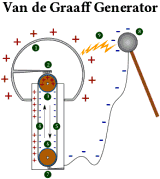 Mechanically
generated electrical noise has been the bane of wireless communications since the
days of Marconi. I recently posted a 1930 article from Radio-Craft titled
"More About 'Man-Made' Static" that addressed the plague. Electrical
noise adversely affects electronics in a manner ranging from relatively harmless
but annoying interference to destructive discharging. We are very familiar with
electrostatic discharge (ESD) and the hazard it presents to electronic devices.
Triboelectric charging and a subsequent rapid discharge is the culprit. Much research
has led to ingenuous mitigation and prevention techniques that have practically
eliminated the problem. Still, electrical noise crops up in some of the most unexpected
places and must be dealt with. Mechanically
generated electrical noise has been the bane of wireless communications since the
days of Marconi. I recently posted a 1930 article from Radio-Craft titled
"More About 'Man-Made' Static" that addressed the plague. Electrical
noise adversely affects electronics in a manner ranging from relatively harmless
but annoying interference to destructive discharging. We are very familiar with
electrostatic discharge (ESD) and the hazard it presents to electronic devices.
Triboelectric charging and a subsequent rapid discharge is the culprit. Much research
has led to ingenuous mitigation and prevention techniques that have practically
eliminated the problem. Still, electrical noise crops up in some of the most unexpected
places and must be dealt with.
 An article
dealing with triboelectric charging and static discharge in radio controlled (R/C)
helicopters, with the resultant radio interference, appeared in the August 2015
edition of Model Aviation. Online access is restricted to subscribers;
however, the full content - and more - is available online by the author, David
Buxton, on his RCHeicopterFun.com website. It is a very comprehensive treatment. An article
dealing with triboelectric charging and static discharge in radio controlled (R/C)
helicopters, with the resultant radio interference, appeared in the August 2015
edition of Model Aviation. Online access is restricted to subscribers;
however, the full content - and more - is available online by the author, David
Buxton, on his RCHeicopterFun.com website. It is a very comprehensive treatment.
To summarize, the tail rotor on some R/C helicopters is driven by a rubber belt
running through a metal or carbon fiber tube (other methods
use a rotating drive shaft or a separate electric motor on the tail rotor).
As the image here shows, the configuration forms a very nice Van de Graaff
generator. Under conditions of low humidity and an unlubricated belt, a charge high
enough to cause coronal discharge at both ends of the system can accumulate. Interference
with the older FM radio systems is guaranteed, and when really severe it even occurs
in modern spread spectrum systems that use a combination of frequency hopping and
direct sequence (Futaba, JR, Spektrum, etc.).
My first R/C helicopter (a
DuBro TriStar) waaaay back in the late 1970s generated severe
electrical noise due to the interaction of steel gears. The radio system operated
at 72 MHz so I expect the noise was getting into the IF stage in the receiver,
but it was so bad that I could see the servos jittering with no input from the transmitter.
I tried wrapping the receiver and servos in aluminum foil and bonding as many bolted
parts as possible, but never did completely eliminate the problem. In retrospect,
what might have worked would have been to fabricate spring-loaded finger stock to
rub against the main rotor shaft and tail rotor shaft that would be bonded along
with everything else. Then again, that might have just added even more noise.
Posted August 28, 2015
|



























 An article
dealing with triboelectric charging and static discharge in radio controlled (R/C)
helicopters, with the resultant radio interference, appeared in the August 2015
edition of
An article
dealing with triboelectric charging and static discharge in radio controlled (R/C)
helicopters, with the resultant radio interference, appeared in the August 2015
edition of 